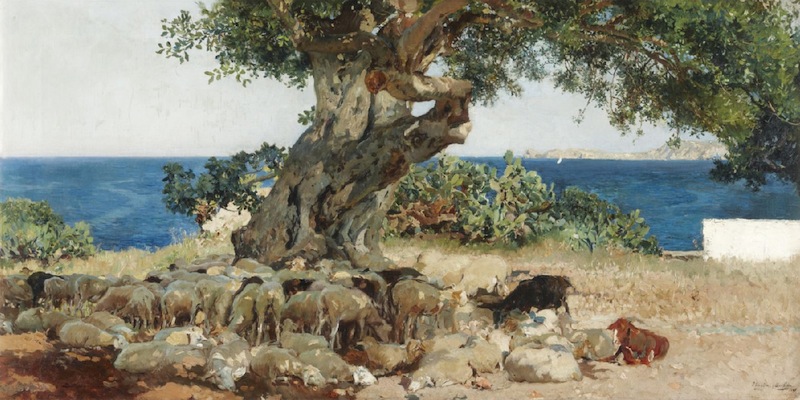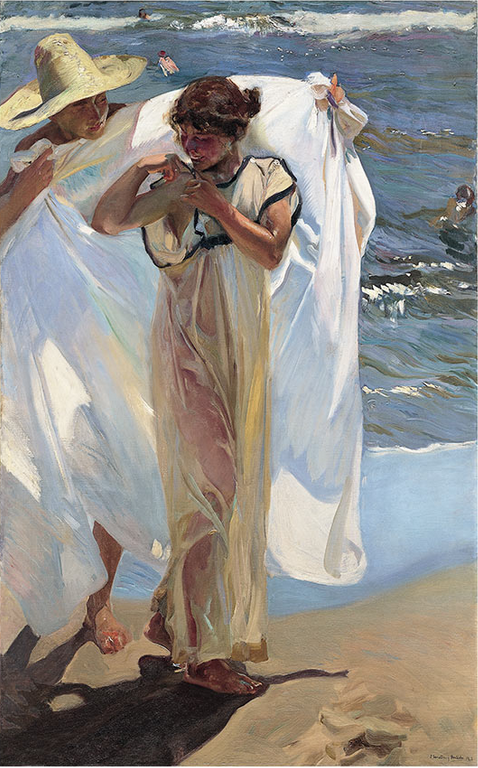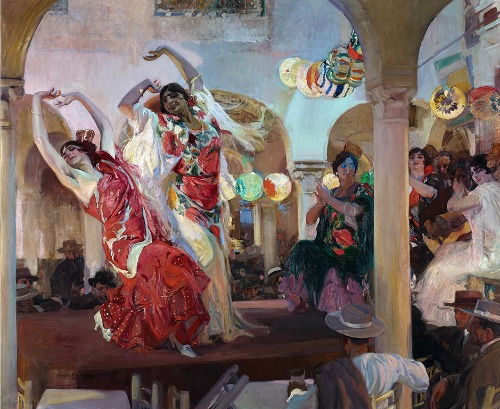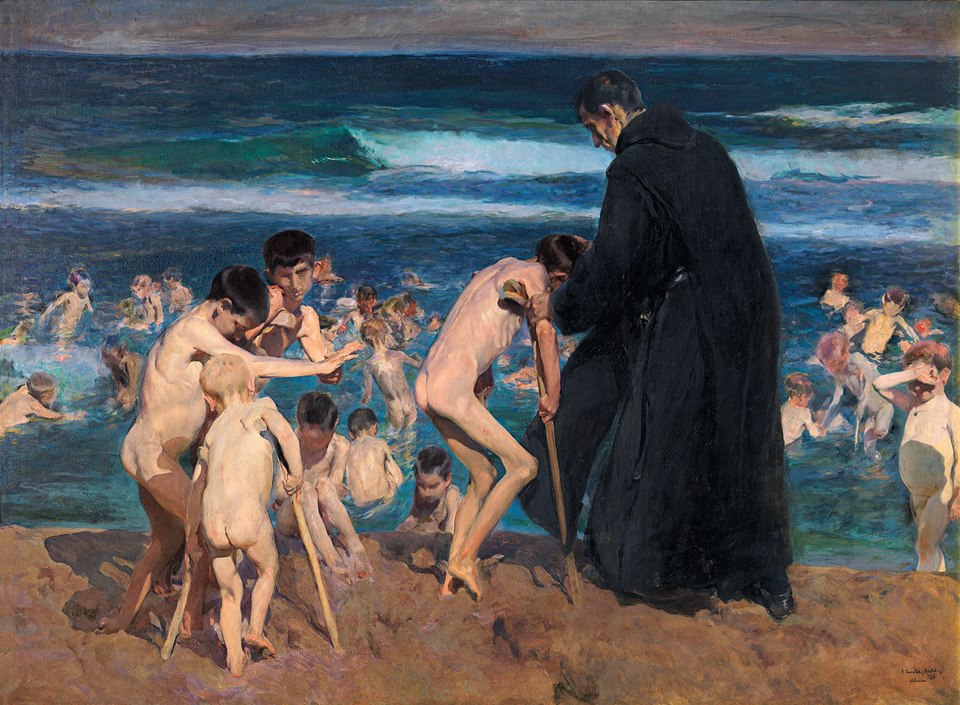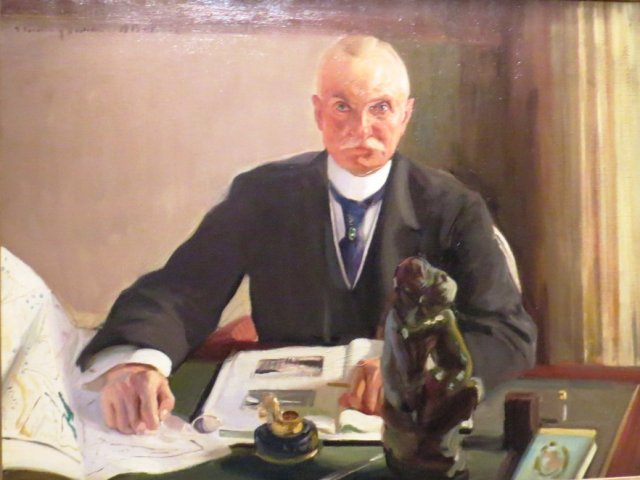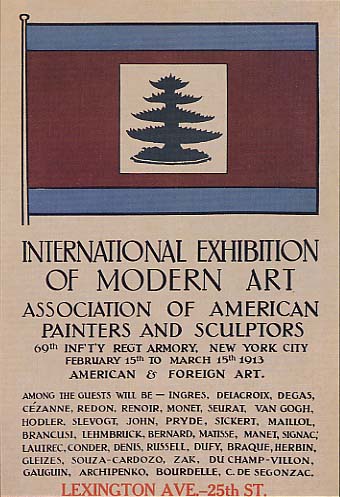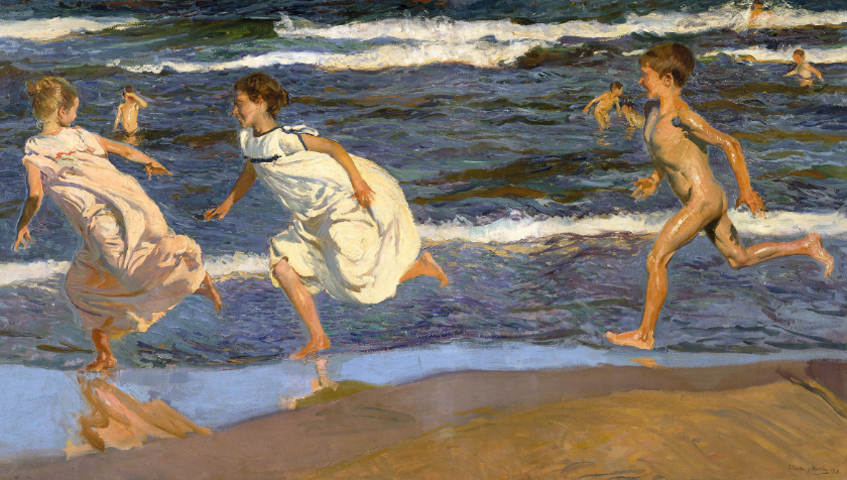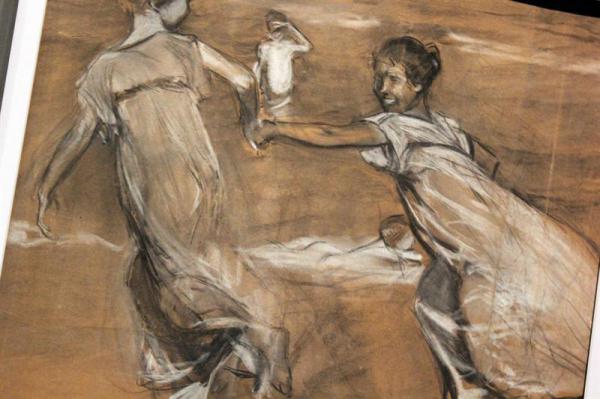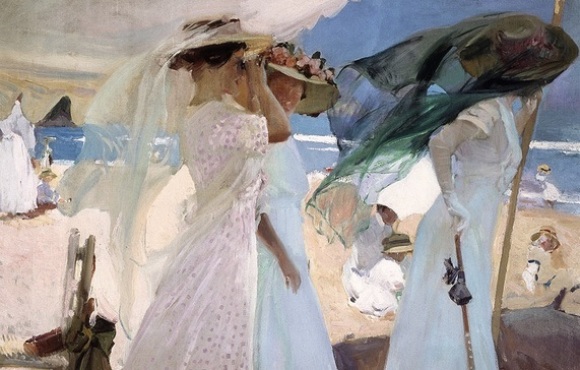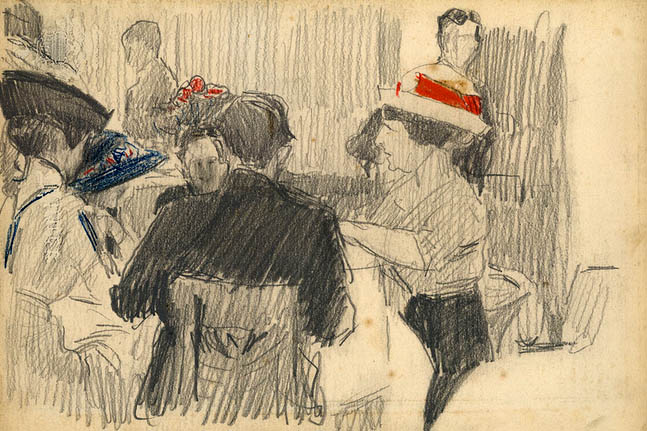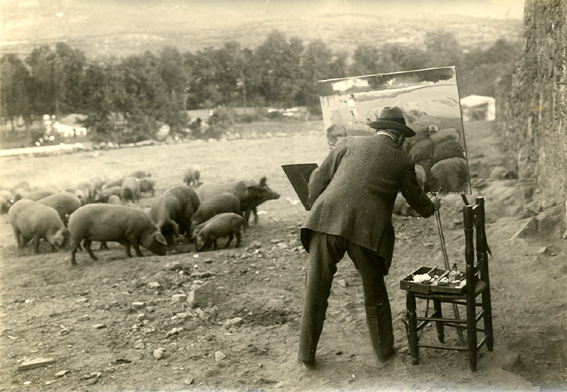Sometimes it happens. Some exhibitions like a hit of emotion. As with the deepest experiences of love: irrational. And this time it happens to us. We leave the traffic of Recoletos, climbed the stairs of the old palace of Madrid, headquarters today of the rooms of the Mapfre Foundation: Sorolla and the United States. Room 1. Dark and small inside: El Algarrobo welcomes us, as only he is illuminated. A medium format frame, landscape, far from the monumentality of Sorolla. We remember how to enter directly into the blue sea that reflects the sapphire blue Mediterranean, in the light of noon. Bright blue, with its minimum stroke of a white spatula forming a wind sail, Sorolla's characteristics.
|
Author: Marina Valcárcel
Art Historian
|
 |
"I wish I was not so excited,
because after an hour as today, I now feel undone,
exhausted, I cannot take more pleasure, I can´t resist like before ...
It is that painting, when he feels, is greater than all;
I said wrong: what is natural is beautiful "(Joaquín Sorolla)
Sometimes it happens. Some exhibitions like a hit of emotion. As with the deepest experiences of love: irrational.
And this time it happens to us. We leave the traffic of Recoletos, climbed the stairs of the old palace of Madrid, headquarters today of the rooms of the Mapfre Foundation: Sorolla and the United States.
Room 1. Dark and small inside: El Algarrobo welcomes us, as only he is illuminated. A medium format frame, landscape, far from the monumentality of Sorolla. We remember how to enter directly into the blue sea that reflects the sapphire blue Mediterranean, in the light of noon. Bright blue, with its minimum stroke of a white spatula forming a wind sail, Sorolla's characteristics. It is the sea of Javea in 1898, with its soft pink coast in the background. The protagonist is an old carob tree nearby; the Eastern Mediterranean, with connotations of absence, which leads to the baby-boomers who, in the absence of chocolate, enjoyed sucking their sweetpods as a treat.
In its twisted trunk there are shadows of the Sorolla palette; short brushstrokes and ochre material, grey and black with contrasting blue-green fleshy leaves, with a prickly row of pears left behind, in the sun. And that ends in a white washed wall with a white as hurtful as it is cheerful.
The shadow of carob is home to dozens of sheep and goats. The siesta. Dead spots and holes from the sun. The radiant light of that sea. We almost anticipate a fly buzzing, the rattle of sheep, a mixture of the smell of the sea with a herd and a tree, almost the exact temperature and warmth of this Levantine landscape that transports us with a myriad of sensations.
We approach to read the label of this picture. Under the title and date, provenance: Private collection, USA.
Sorolla: El Algarrobo, 1898.
We turn around to its companion picture: Port of Valencia, this time the Cincinnati Art Museum. Rarely have we seen such audacity in a painter to capture light on a basket or white hat. So much so that the elements, in this case the basket, or wide-brimmed hat, are nothing more than an excuse, a shield emanating light. It would seem that it forms with light. It's a classic scene in Sorolla: the active sea, the harbor, fishing. The boats, with children jumping into the water from them. We immediately think of many other targets: the ones of Zurbarán, more mystical and conventional, in their tablecloth fabrics or chasubles dense thread, also in the thick strokes of Rembrandt as light bulbs that light up the darkness. Even in Velázquez or in some Venetian painters of XVI. They have nothing to do with the message of these targets coming out of the sun, with light, warm air turning to shades that almost introduce scents: the vanilla wafer, summer, the coast, the west, to joy ...
What have these two pictures in common next to the other two -´Another Margarita !!´ and Los pimientos- hanging on the walls of the first room? Sorolla always felt a transnational painter. These four pictures show how before the arrival of the painter to the United States, for his major exhibitions of 1909 and 1911, some of his works already belonged to American collections. Port of Valencia or El Algorrobo were purchased through European dealers who acquired works in exhibitions in Paris, Munich, Berlin and London and are the preamble to what Blanca Pons-Sorolla, curator of the exhibition, comes to announce as the theme of this exhibition.
After the retrospective of Sorolla in the Prado Museum in 2009, it is now the Mapfre Foundation which brings us to the moment of triumph, in the middle of the fullness of his work. Sorolla in the United States. For this to be together, for the first time in Spain, a group of works, many never seen here, which were exposed by the painter in his American samples and purchased by collectors and museums in the United States.
Sorolla: Saliendo del baño, 1908.
Joaquín Sorolla was born in 1863 and died in 1923, 60 years and five months old. We must understand what the political and cultural context in which the painter´s life goes through to assess precisely the merit of his American triumph.
Sorolla's life covers the period of the Restoration and the parliamentary monarchy of Alfonso XIII. It is a stage of political stability in Spain, so it is also in the economic field. However, a deep rift divides the country: political Spain on one side and the royal Spain on the other. The field remains stuck in stagnation, while an oligarchic bourgeoisie consolidates. Both are faithfully portrayed by Sorolla.
Furthermore, the settlement of overseas empire occurs in 1898. The country is almost reduced to its present limits. This has a direct impact on the intellectual movement that leads to a controversy which arises both in the field of literature as in painting and other visual arts. That fracture divided Spain in what came to be called the black Spain (term coined by the book by Emile Verhaeren and Darío de Regoyos, 1899) faithful to a nation at the crossroads, anchored in its medieval and dark roots. A Spain guided by artists like Ignacio Zuloaga to Julio Romero de Torres, also by the great authors of 98, Unamuno, Valle-Inclán, Baroja ... Faced with this darkened Spain, a white and bright Spain shone, born with the joy of living in the present. Next to this Spain were other painters apart from Sorolla as Hermen Anglada-Camarasa or José Pinazo.
In the field of painting, which is the present one, it is curious to know that this controversy even affected the world of colours. In Sorolla, all of his energy is manifested in the power of the chromatic material, in full thick brushstrokes with thousands of combinations of tones which advanced the joy of life. While Zuloaga y Romero de Torres belonged to the current Unamuno who, in his denial of any substance sensuousness as art, rejected all the elements that confer greater physicality to a picture, by oil painting or colours. For him only grey would fit "because the grey tends to behave like a vampire of the colors, because when mixed with them it is in charge of sucking the blood, the life strength, up until emptying themselves." It is in this context that, for example, imagine our Valencian painter, easel in hand, touring Spain, by painting on giant canvasses, full of strokes and patches of colour, noise and optimism to be hung in a Hispanic Society at farthest from noventayochista pessimism.
Sorolla: Dancing in the Café Novedades of Sevilla, 1914
Nothing more out of this first room we finally start with the enormous Sad Inheritance! (1899). Sent to the Universal Exhibition in Paris with five other paintings, the jury awarded the Grand Prix Sorolla by all, but especially for this work here, within these walls, it seems drowned between a floor and a ceiling too close for her. We think it is the only sea painting of Sorolla where the beach is pure melancholy. It's not the bright and cheerful July or August light, nor the golden September; it is a cold light, like of early June. The sea, even the waves and sand, blue and white, seem to have been mixed far too much on the palette with a huge splash of priest's cassock bitumen color, which also makes his hard profile stand out. The rest, those emaciated young are the only bodies of children that Sorolla painted in the sea whose skin is not covered by this transparent, cheerful and slippery film that is the brightness of salt water and what makes it something like metallic fish reflections.
Sorolla here becomes austere, even in the amount of material used in the stroke: dispenses with all sensuality abuse thick patches of colour limiting to almost scraping with the spatula. Returning to those poor children head down with shaved hair and those who do not paint eyes, to the ephemeral misery in their time of joy. Plunging themselves into a water cooler than ever. In a sea that almost becomes the Atlantic.
Source of picture: Purchased in 1902 by J. Vidalin NewYork.
Sorolla: ¡Triste herencia!, 1899.
SOROLLA AND HISPANIC SOCIETY.
The ground floor of the exhibition is dedicated to the two great patrons of Sorolla in the United States: Archer Milton Huntington and Thomas Fortune Ryan.
Sorolla: Thomas Fortune Ryan, 1913.
Huntington founded the Hispanic Society in 1904 to promote Hispanic studies and bring the American public to the Spanish culture. Not only in relation to painting, but also with literature.
In 1909 he organised the first major exhibition of Sorolla in the United States, in the rooms of the Hispanic Society of New York. It was a resounding success, both in sales and assistants to the exhibition, as well as the support from a glowing review. This first exhibition later travelled to Buffalo and Boston where they were received with similar enthusiasm. Sorolla's second triumph came two years later in 1911 in Chicago and St. Louis.
As a result, Huntington entrusts "the work of his life": fourteen panels to decorate the library of his headquarters in New York. Sorolla took only eight years to make this request: from 1912 to 1919. Shortly after completing the last canvas, and probably due to the superhuman effort he performed, he suffered a stroke and in 1923, three years after, he died.
When in 1926 the paintings were finally hung on the walls for which they were conceived, both in America and in Spain this fact went almost unnoticed, fading between the press and criticism so far from the overwhelming triumph of Sorolla a few years before.
What had changed over the eight years in which Sorolla had covered the Spanish geography even painting it in the wake of the success of the exhibitions of 1909 and 1911?
There are two facts that spun the sensitivity of the American and European companies. First of all, the First World War, but above all, a crucial event in the development of the fine arts: where in New York the Armory Show took place and made its way, blowing all the locks on all the doors, the avant-garde spirit.
Armory Show, English name of artistic exhibitions held in the armory of the 69 Regiment of the National Guard in New York, is the term that refers to the International Exhibition of Modern Art that took place between February 17 and March 15, 1913. This exhibition was a turning point for American art focusing it toward modernity and distancing the hitherto dominant academicism. It brought together some 1,300 pieces that roamed the development of contemporary art with representative works of Impressionism, Symbolism, Post-Impressionism, Cubism and Fauvism.
Apart from the density of ideas that characterised this movement, there is one that sums it up well: the forefront is the prioritisation of the discourse on the figure.
The artists who moved around the 1900s, we would say between the last quarter of the nineteenth century until 1914, did so shuffling the dialectic between discourse and figure, looking for a communication between them. But from 1914, speech, meaning, sought independence from the matter that constituted the body: the soul tried to become independent of the body that gave life and consequently the fine arts wanted to separate from the material that it conformed. The basic idea of departing was replaced by the will of transcendence: of intangible meaning.
The center of this edgy hurricane was Marcel Duchamp and his obsession with getting away from plastic sensory.
In short, the ideas were interesting; painting now looked at the service of the mind and the antisense speech that led to the vanguard collided head-on with the painting of Sorolla, essentially sensory and sensual. Sorolla was obsolete.
It was not until the XXI century where the anti-vanguardismo shows its breadth when the figure and fame of Sorolla are returned to the place they deserve. There are 20 paintings in the collection of the Prado Museum.
VALENCIA BEACH, THE PORT, CHILDREN IN THE SUN, THE LANDSCAPES AND PORTRAITS OF CLOTILDE AND ELENA THAT FLOOD NEW YORK ...
Sorolla: Running on the beach, 1908.
"The air was impregnated by miracle everywhere. People quoted the number of visitors and he continually had in his mouth the words" sun glare. "Never had anything like that happened in New York. The ohhh and ahh´s misted floor tiles, cars jammed the street. Portrait orders poured in. Photographic reproductions were sold in unseen quantities. And through it all, there was our little creator. Sitting quietly, overwhelmed but not cocky, while I would translate the waves of enthusiasm from the press. "
(Letter from Archer Huntington to his mother , Arabella Duval Huntington New York, March 1909).
And yes, with this letter from his mother Huntington we understand part of the revolution that Sorolla created in New York in the beginning of the century, flooding it with the Mediterranean light, of the joy of this mysterious inland sea.
In a sort of time warp we imagine ourselves converted to American viewers, moving for the first time, stunned amongst the paintings of Sorolla.
How would we react seeing ourselves surrounded by scenes of sea and beach - girls with pink dresses and loose buns running hand in hand, jumping on their reflections that turned into torrents of colors and light. Persued by the naked body of a child, in a jump, after a blue and violet sea crossed by horizontal waves which look more like grins, with baby teeth and screams rather than foaming curls? Would we notice, in the winter across the Atlantic, how light brightens the colors to its fullest, irradiating them until they are put into our thick coats closed with buttons and filling them with a feeling of warmth and comfort which the paintings of Sorolla always give? Accompanying this canvas, Running on the beach (1908, bought by E. Huntington, in New York in the exhibition, 1909) a series of preparatory drawings on paper where the spirit of Sorolla already announced the use of charcoal and graphite sculpting the folds of the robes of the girls almost as if they were a korai of classical Greece, defining his arms, organising her hair, off the extensive patches of bright pastel white are those that breathe life into the figures and faces of girls.
Sorolla: Girls running III. Study for Running on the beach, 1908.
"THIS ARTIST OF VALENCIA HAS FOUND HIS TREASURE IN BLUE WATER. BUT THE DOMAIN OF THE SEA HAS NOT BEEN ACHIEVED BY JOAQUÍN SOROLLA IN ONE AFTERNOON. HE IS SAID TO HAVE a BROKEN ARM DUE TO ROWING AND A SUNBURNT FACE"
(Juan Ramón Jiménez)
Much in the style of Sorolla , there is a lot of his personality: vital and passionate, just painting conceived as a vehicle for his feelings and his way of seeing things. The painting was his life and in that sense there was dissociation between life and work, between man and the artist. I felt things directly, away from the depths or paused reflections.
His life is lengthened as a stroke over his painting. He maintained a constant communication with the world that inhabited his paintings: with himself and the things he painted, with himself and the people whom he painted from Clotilde, his wife, to his sons and his models. He painted what he liked, especially the sea and its surroundings. Everything had to be cheerful, cool, loud, flooded with light. He painted everything with strength and vigor. He was a temperamental and emotional man and could not engage in something that did not attract him overwhelmingly. In cases where he should engage in a portrait commissioned corseted, the quality of his work was suffering. He moved away from all that gave him coldness. The sobriety of Castilla would frighten him. When painting Castilla he said: "I painted all day and I'm not happy with the work (...) I do not know what happened here (...) but it attracts severity (...) I am less encouraged to continue in Avila, the Castilian bothers me, it is too barbaric. "
And yet he was excited with Andalusia, with the partying and the bulls ...
Analyzing this position –vitality against intellectuality- we discover how art moved and fascinated him. And so we see how Sorolla never showed any interest in taverns; he stayed away from any art analysis as cubist art was, that developed alongside him. Between 1907 and 1914, Braque, Picasso and Gris convert still life into one of their favourite genres: they planned to reduce nature to simple geometric shapes. Nothing too far off from the paintings of Sorolla.
Sorolla: Under the awning,1910.
The fundamental characteristic of his work is the search for the natural. It is true that in his paintings one can see traces of Naturalism, Impressionism, even Fauvism, but always in his way.
He shared many traits with Impressionism: the plenairismo, a clear palette, the tendency to sketch, the weakening of the issue in favor of the environment ... However, unlike his Impressionist colleagues, he did not come close to science in search of the decomposition of light and colour properties. That intellectual search Sorolla disliked and was devoted entirely to the pure emotion and what he saw as natural. "What for? If the normal eye sees colour together why, then separate it?".
"I AM HUNGRY TO PAINT(...) I SWALLOW, I OVERFLOW, IT IS CRAZINESS"
(Sorolla)
This exhibition also shows an overwhelming quality of Sorolla: the indefatigable worker, lucky beast unable to stop.
They are great rooms, also dark, small, crowded, certainly turned into Studioli or jewellery cabinets, in which the viewer enjoys the notes made by Sorolla, either on their small oil boards with landscapes and sketches, along with his drawings from the US hotels or the back of menus of Parisian restaurants.
Sorolla: Coffee Scene, 1911.
"When do I paint? Always. I'm painting now, I look at it as I talk to you".
Sorolla made more than two thousand small paintings throughout his life. They did not exceed 20 or 30 centimetres. The so-called "notes" or "color spots ". And he painted them for himself, for pleasure, like sketches or essays that conveys the artist's soul. They were a scanner of how the painter looked or felt. His most intimate and free side.
They were the immediacy of the look: one that looks and paints at the same time. Hunger of the painter for letting his hand, like a writer extends its pulsations in an outline of what he is seeing or feeling: out of necessity to vomit what explodes within him.
That uncontrollable lava which Sorolla advanced in his studies of nature, capturing snapshots, light changes, no matter if it were a piece of a wall and his limed white, the reflection of a tree in the water of a pond, the arms of children reduced to tiny strokes, alternating with touches of the spatula, to capture their jumps in the waves ... This custom of the notes, to paint for himself and the small format was already known from Goya and developed by painters who took their paints outdoors, whether it be Fortuny or Pinazo, Sargent or Boudin. It seemed that Fortuny had invented an ingenious box of notes that facilitated the convenience of outdoor studies. It was a box with two parts connected by hinges: the bottom to act as a palette and where colour tubes and brushes were kept; at the top, was the small board in a manner that when standing, could receive the painter´s creation.
These notes become especially interesting in the end, when freedom and the security itself is already full. They become evidence of the advancement of the technique and the search for light, while the shadows are forced to the limit and painting sharpens its modernity to remind us that Sorolla works at the time of the photography and passion for Japanese stamps.
"Now is when my hand listens completely to my retina and my feeling. Twenty years later!" said the painter at the end of his life.
{youtube}okIP00Hoc3E|600|450{/youtube}




